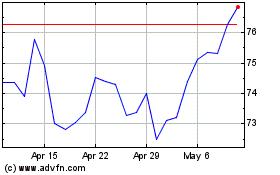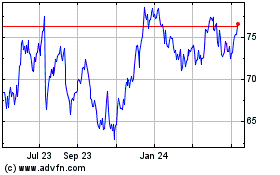UPDATE: FDIC Approves Plan For New Small-Bank-Friendly Deposit Formula
November 09 2010 - 10:47AM
Dow Jones News
U.S. banking regulators on Tuesday approved an initial plan to
change the way they calculate how much banks pay for deposit
insurance, placing a greater burden on bigger banks.
The Federal Deposit Insurance Corp., which guarantees deposits
in the event of a bank failure, currently charges banks quarterly
fees based on the total domestic deposits.
The new Dodd-Frank financial overhaul law directs the FDIC to
change that formula. The FDIC is proposing to base the fees on a
measure of banks' assets, a formula that favors smaller banks.
FDIC official said banks with $10 billion or more in assets
would pay 80% of total insurance fund fees, up from 70%. Most of
that increase would be shouldered by the very largest banks, those
with $100 billion or more of assets.
The change will mean the three largest banks, Citigroup Inc.
(C), Bank of America Corp. (BAC) and JPMorgan Chase & Co. (JPM)
will pay a combined $1 billion in additional premiums every year,
said James Chesssen, chief economist at the American Bankers
Association.
"It's a very large cost for the very largest banks," he
said.
Acting Comptroller of the Currency John Walsh called the new
system "a sea change."
"It breaks the link between deposit insurance and deposits for
the first time," he said. "This is quite significant."
Under the FDIC's proposal, those fees will be calculated based
on a bank's average total consolidated assets, minus tangible
equity, such as common stock.
The new assessment system would start on April 1, 2011, after a
45 day public comment period, during which the agency could make
changes to the proposal. The April 1 start date would call for the
new charges to take effect in the second quarter of next year.
Community bankers stand to save billions in fees under the new
assessment scheme and have championed the measure. They pitched it
as a way to hold the largest firms more accountable for the greater
risk they pose to the financial system.
The provision "will ensure that these institutions pay their
fair share," Camden Fine, president of the Independent Community
Bankers of America, said during the House debate on the bill.
The new assessment formula gained traction during the Dodd-Frank
bill negotiations, backed by the anti-Wall Street sentiment that
fueled a crackdown on the country's biggest banks. It drew far less
notice than a proposed bank tax or efforts to break up the largest
financial firms.
Smaller banks rely more on bank deposits to provide money for
lending. Larger banks, by contrast, have access to other sources of
funding, such as the commercial paper market.
The FDIC proposal is revenue neutral. Because the proposal would
broaden the assessment base, FDIC officials said the overall rates
banks pay would fall to a range of 0.05% to 0.35%, from a range of
0.12% to 0.45%.
The FDIC proposal would give a special adjustment to so-called
custodial banks and bankers' banks, essentially giving these
institutions a break on a low-risk portion of their balance sheets
due to their unique business models, FDIC officials said.
Bankers' banks provide financial services to smaller banks and
don't provide retail services to the general public. Neither do
custodial banks like State Street Corp. (STT) and Bank Of New York
Mellon Corp. (BK), which instead act as agents in securities sales
and transactions for institutional investors and brokerage
houses.
Also Tuesday, the FDIC proposed a new system to assess the risks
posed by the largest banks. Under the agency's new formula, those
institutions would be evaluated based on the risks they pose to the
financial system and their probability of failure.
So far this year, 141 banks have failed, eclipsing last year's
total of 140. The FDIC last month lowered its estimates for bank
losses to the deposit insurance fund to $52 billion from 2010
through 2014. That's down from $60 billion in losses predicted in
June. The change is due to projections that bank failures this year
will be less costly than anticipated.
As a result, regulators have decided to forgo a planned rate
increase on banks paying into the FDIC's insurance deposit
fund.
-By Alan Zibel and Victoria McGrane, Dow Jones Newswires;
202-862-9263; alan.zibel@dowjones.com
State Street (NYSE:STT)
Historical Stock Chart
From May 2024 to Jun 2024

State Street (NYSE:STT)
Historical Stock Chart
From Jun 2023 to Jun 2024
